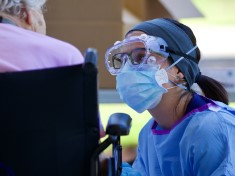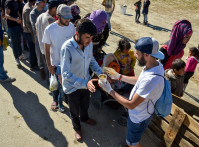-
Highlights from the First-Ever State of the World’s Nursing Report
May 15, 2020 By Amanda King
The year 2020 has been designated as the Year of the Nurse and the Midwife by the World Health Organization. In April 2020, the World Health Organization (WHO), International Council of Nurses, and Nursing Now, published the first-ever State of the World’s Nursing Report. This week’s Friday Podcast highlights remarks from a recent Wilson Center event on the report’s findings and recommendations, gender implications in the health workforce, and the role of nurses during the COVID-19 pandemic.
The year 2020 has been designated as the Year of the Nurse and the Midwife by the World Health Organization. In April 2020, the World Health Organization (WHO), International Council of Nurses, and Nursing Now, published the first-ever State of the World’s Nursing Report. This week’s Friday Podcast highlights remarks from a recent Wilson Center event on the report’s findings and recommendations, gender implications in the health workforce, and the role of nurses during the COVID-19 pandemic.
One of the most exciting things about the report is the evidence on the nursing profession. The data gives nurses the opportunity to find their voices, said Barbara Stilwell, Executive Director of the Nursing Now Campaign. Instead of saying they need more nurses because they feel short of staff, they can present data to decision-makers to show that more nurses are needed on a ward. “You can put it in a graph like Florence Nightingale did and you can take it and show it and make your case for being given more resources,” said Stilwell. “And that’s exactly what’s happening now where we see nurses advocating for more resources to help them deal with the pandemic.”
While report findings show that approximately 90 percent of the world’s 28 million nurses are female, they still operate at a disadvantage compared to their male colleagues when it comes to pay equity, hiring, education, and workplace violence and harassment. “The same systems and structures of marginalization or oppression that we see in society such as sexism, racism, patriarchy, we also see these reflected in health systems,” said Rosemary Morgan, Assistant Scientist for the Bloomberg School of Public Health and School of Nursing at Johns Hopkins University.
While the vast majority of the nursing workforce are women, men hold most nursing leadership positions. “We must have a gender transformative leadership development program for women in the nursing workforce,” said Leslie Mancuso, CEO and President of Jhpiego. She called for nurses to have equal standing and a level playing field in pay and practice. Nurses, she said, should be treated equally regardless of gender, degree, or wages. One way to ensure that female nurses are adequately represented in nursing leadership is to invest in nursing.
The report highlights that we spend 25 percent of the healthcare education budget globally on nurses and midwives who make up 59 percent of the workforce. But that large a shortage may not be acceptable, given what it means for people’s work-life balance, stress, pressure, burnout as well, said Howard Catton, the Chief Executive Officer of International Council of Nurses.
WHO is working on investments in the health workforce to address the 6 million shortfall in nurses. The solution involves not only investment for education and training to increase the supply of nurses, but also creating decent, well-paid jobs with good working conditions, said Michelle McIsaac, Economist at WHO and Co-chair of the Global Health Workforce Network Gender Equity Hub.
While the data are impressive, so are the gaps in reporting, said Jennifer Breads the Gender Technical Advisor at Jhpiego, particularly around entry-level salaries, educational investments, labor market flows, and gender wage gaps.
The COVID-19 pandemic has illuminated the importance of nurses globally. Now more than ever, special attention needs to be focused on nursing. “Nurses remain the heroes we have in tough times that we are in today and they need our support,” said Emily Katarikawe, Country Director of Jhpiego Uganda.
Source: World Health Organization
Photo Credit: Jennifer Romero, a registered nurse with the Florida Department of Health, explains the process of the specimen collection to a nursing home resident in Northeast Florida, May 1, 2020. Photo courtesy of Sgt. Michael Baltz.
Friday Podcasts are also available for download on iTunes and Google Podcasts.
 A Publication of the Stimson Center.
A Publication of the Stimson Center.







